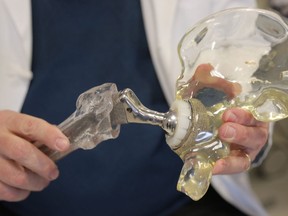Make no bones about benefit of joint replacement

Article content
One of the most often performed surgeries in the western world is joint replacement.
The most common are knee and hip joints. The need for this surgery is to alleviate a painful condition when the joint has worn out and the bones start rubbing against each other. In severe cases, this condition can be crippling.
To understand what is happening, you must know a little about the construction of joints, which are places where the body can bend. As our skeleton provides shape and structure to our bodies it is necessary to have places where the bony structure has breaks so the body can bend.
Our bones are constructed such that the ends of bones at joints tend to enlarge to provide a greater bearing surface for the joint to ensure that the stress is spread over a larger area and the pressures at joints, such as the knee and ankle, which are highly stressed, can have manageable pressures within the joint. While this might appear to solve the problem of providing a flexible joint, it is only part of the solution.
Unlike most common belief, bones are not just solid mineral structure. Bones are mostly composed of collagen, a living, growing tissue. It is a protein that provides a framework for the mineral component of the bone, which is mostly calcium phosphate. It is this mineral that provides the strength and flexibility of our bones.
When you think about it, our bones have a difficult job to do. They provide the structural framework for the body while retaining the ability to grow and to heal injuries. It must be strong, yet flexible to allow for some bending before it finally breaks. As well, it must have the ability to heal itself after injuries such as breaks and be strong when healed. The more bones are stressed, the more mineralization that takes place and the stronger the bone becomes. People who have jobs that stress their skeletons end up with particularly strong bones that are able to carry the loads required of them.
Bones, however, make poor bearing surfaces that are highly stressed. This happens at joints, particularly the knees and hips, where large bearing forces are encountered in daily living. If bones were allowed to rub together, they would quickly wear our and leave you in severe pain and unable to walk. Fortunately for us, bones are coated on these bearing surfaces with a slippery material called cartilage. As well, the joints tend to be surrounded by a membrane that contains something called synovial fluid, which provides lubrication to the joint.
Unfortunately, cartilage does not tend to repair itself as it wears. The amount of cartilage you have when you are an adult is all you are going to get. If your cartilage wears out, you will find your bones start rubbing each other raw. As bones are not designed for this task, they quickly become necrotic, that is the cells die and the joint becomes difficult to move and painful. This kind of wear tends to be on joints that have a large range of movement and are located in high-stress areas of the body.
The worst joints for stress concentration are knees and hips. As they wear out, movement becomes more limited and painful. This is a crippling condition. Until now, the only solution we had was to go in with a fairly invasive surgery and lop off the necrotic bone and replace it with titanium and plastic prosthetic components. If you are interested, you can watch this surgery on YouTube, but you do need a strong stomach. As brutal as this surgery is, it provides miraculous relief of pain and tremendously improves mobility. Now, scientists at the Stanford School of Medicine in California ave found a way to regenerate cartilage that has been damaged or worn out using chemicals to stimulate stem cells to replace the damaged cartilage.
Should it work, this discovery will improve the lives of hundreds of thousands of people who can avoid invasive surgery.
Tim Philp has enjoyed science since he was old enough to read. Having worked in technical fields all his life, he shares his love of science with readers weekly. He can be reached by e-mail at: tphilp@bfree.on.ca.
Postmedia is committed to maintaining a lively but civil forum for discussion. Please keep comments relevant and respectful. Comments may take up to an hour to appear on the site. You will receive an email if there is a reply to your comment, an update to a thread you follow or if a user you follow comments. Visit our Community Guidelines for more information.